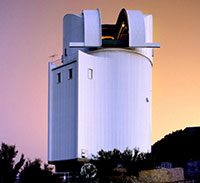 On the morning of Dec. 3rd, LPL’s Vivian Carvajal, working on a joint asteroid survey project between Spacewatch and the Catalina Sky Survey (CSS) and using the 90" Bok telescope on Kitt Peak, discovered an imminent Earth impacting asteroid, which fell over Russia. This was the 11th such object to be found ahead of impact (6 out of 11 being found by CSS), the first impactor discovered by Vivian, by the joint project, and by a telescope at Kitt Peak. While all of these small objects burned up harmlessly in the atmosphere, these are fantastic tests of the entire asteroid early warning system of which CSS and Spacewatch are key players. Congratulations to Vivian and the entire CSS and Spacewatch teams!
On the morning of Dec. 3rd, LPL’s Vivian Carvajal, working on a joint asteroid survey project between Spacewatch and the Catalina Sky Survey (CSS) and using the 90" Bok telescope on Kitt Peak, discovered an imminent Earth impacting asteroid, which fell over Russia. This was the 11th such object to be found ahead of impact (6 out of 11 being found by CSS), the first impactor discovered by Vivian, by the joint project, and by a telescope at Kitt Peak. While all of these small objects burned up harmlessly in the atmosphere, these are fantastic tests of the entire asteroid early warning system of which CSS and Spacewatch are key players. Congratulations to Vivian and the entire CSS and Spacewatch teams!
Department News
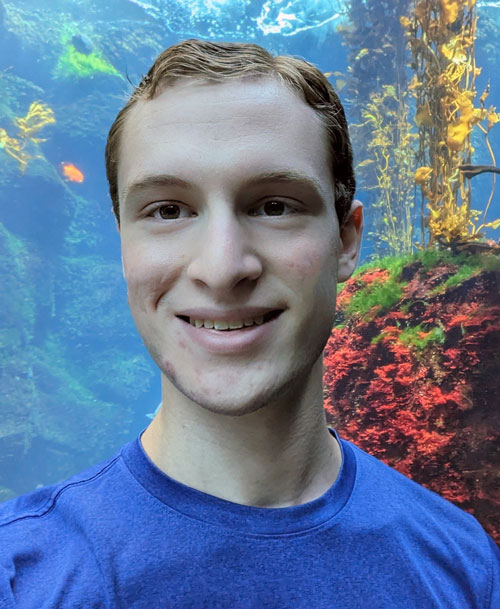 Noah is majoring in Ecology & Evolutionary Biology with minors in Astrobiology, Marine Science, and Geosciences. When Noah chose his major he decided to add a minor that satisfied his interest in space science and would help answer his big questions like “Where did we come from?” and “Are we alone in the universe?” He also wanted to take advantage of being on campus with such great space science programs!
Noah is majoring in Ecology & Evolutionary Biology with minors in Astrobiology, Marine Science, and Geosciences. When Noah chose his major he decided to add a minor that satisfied his interest in space science and would help answer his big questions like “Where did we come from?” and “Are we alone in the universe?” He also wanted to take advantage of being on campus with such great space science programs!
Noah really enjoyed taking PTYS 214: Life in the Cosmos with Dr. Dante Lauretta. He took this course in Fall 2023 when the OSIRIS-REx asteroid sample returned to Earth and was able to hear first-hand from Dr. Lauretta about the mission details and sample return. Dr. Lauretta’s enthusiasm inspired Noah to be more involved with astrobiology.
To support his passion for astrobiology, Noah began working at the Arizona Astrobiology Center, where he studies behavior in tardigrades. The project aims to measure any signals that may be produced by the tardigrades in association with the cryptobiosis behavior that makes them extremophiles. He is also completing a senior honors thesis project with Dr. Diane Thompson (Geosciences). The project uses corals to study paleoclimate patterns, specifically using manganese within the coral’s aragonite skeleton as a proxy for understanding wind patterns across the Pacific over time. Noah plans to apply to doctoral programs in evolutionary biology to research life on Earth, past and present, in order to understand macroevolutionary processes that can be applied to predicting how life would evolve on other worlds.
When he isn’t studying or pursuing his research, Noah enjoys spending time as vice-president of the campus Marine Awareness and Conversation Society, focusing on outreach to teach the community about marine biodiversity and ecology.
Thanks to everyone for supporting research, education, and outreach at LPL.
Individual Donors
- Victor R. Baker
- Gordon L. Bjoraker
- Daniel T. Cavanagh
- Laura L. Dugie
- Anthony J. Ferro
- John Gizis
- William B. Hubbard
- Michael J. Kaiserman
- Colin A. Leach
- Christian Carey Lear
- Renu Malhotra
- Robert S. McMillan
- Michael C. Nolan
- Dale Ann Petersen
- Alexander Pimentel
- Jani Radebaugh
- Justin Rennilson
- Michelle G. Rouch
- Al F. Scorsatto
- Maxine M. Youngelman
Corporate Donor
- ExxonMobil Foundation
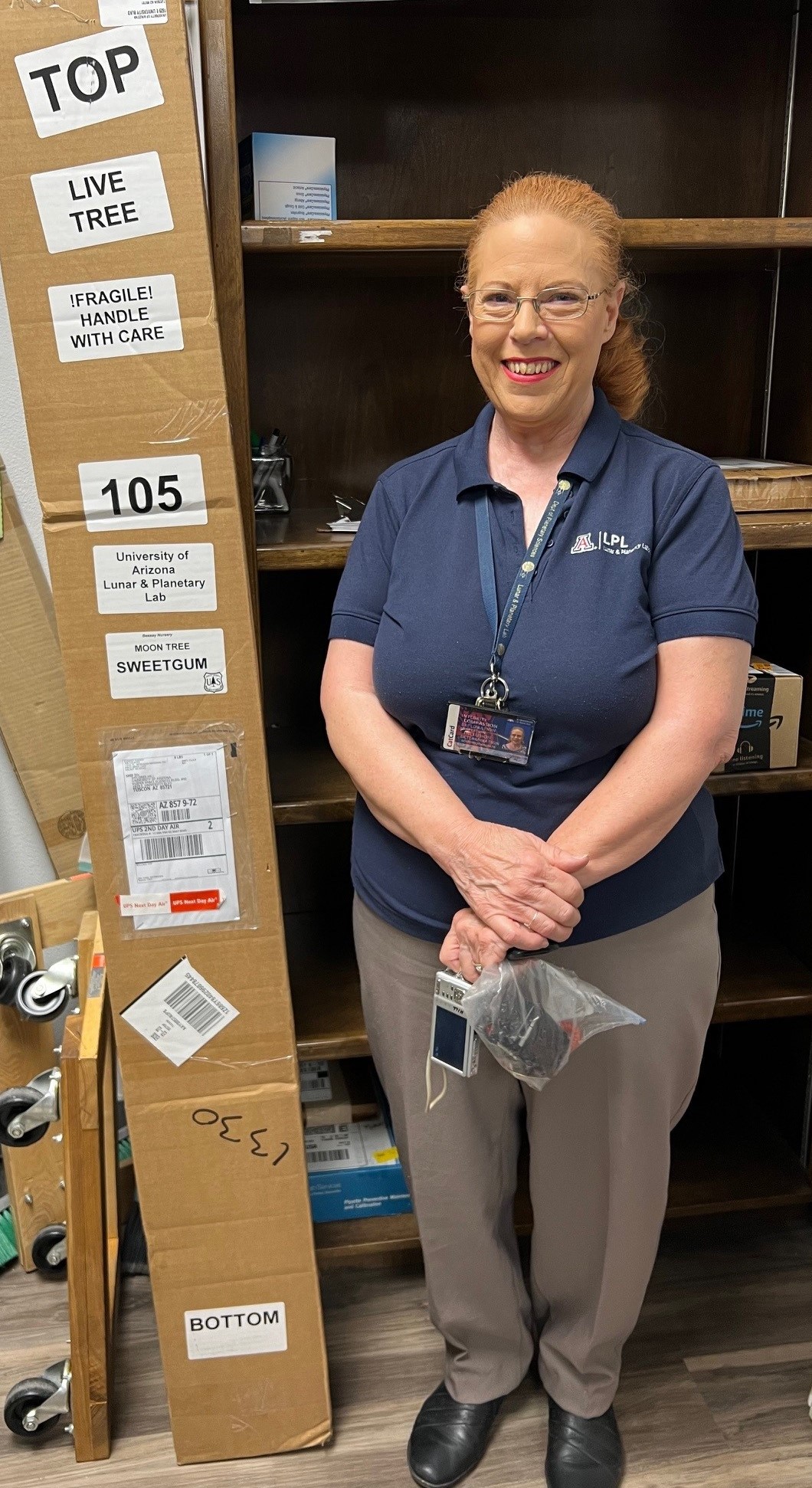 As our cover photo attests, a highlight of this semester was the planting of our second Moon Tree, a sweetgum grown from a seed that flew on the Artemis 1 mission around the Moon. Our original Moon Tree, a sycamore grown from a seed that flew aboard the Apollo 14 command module, has stood between the Kuiper building and Flandrau Science Center for about five decades. Since being planted, tens of thousands of students visiting Flandrau have gathered under the shade of the tree. Our own Dolores Hill is an expert on the Apollo Moon Trees (and reports that ours is the only remaining Arizona one). I asked her to submit LPL’s application for an Artemis tree and we are so grateful that she expertly led the entire process all the way through to planting.
As our cover photo attests, a highlight of this semester was the planting of our second Moon Tree, a sweetgum grown from a seed that flew on the Artemis 1 mission around the Moon. Our original Moon Tree, a sycamore grown from a seed that flew aboard the Apollo 14 command module, has stood between the Kuiper building and Flandrau Science Center for about five decades. Since being planted, tens of thousands of students visiting Flandrau have gathered under the shade of the tree. Our own Dolores Hill is an expert on the Apollo Moon Trees (and reports that ours is the only remaining Arizona one). I asked her to submit LPL’s application for an Artemis tree and we are so grateful that she expertly led the entire process all the way through to planting.
To both protect our young sapling and to provide a spot to enjoy the respite it will offer future visitors to campus, we are aiming to locate a high quality bench adjacent to the tree, with a plaque denoting the significance of the tree. We would be grateful for donations to support the cost of the bench and its installation. Donations can be made online with a designation for the LPL Gift Account with a note in the text box that the donation is for the Moon Tree bench. Abraham Lincoln said that “He who plants a tree, plants a hope.” I think that is particularly appropriate for this tree as we look to the future of LPL’s continuing involvement in lunar research.

Adam Battle
November 15, 2024
Implications of Non-Compositional Effects on Spectral Characterization of Natural and Artificial Space Objects
Advisor: Professor Vishnu Reddy
New position: Postdoctoral Research Associate, LPL, University of Arizona

Mackenzie Mills
October 2, 2024
Evolutionary Landscapes and Resurfacing Processes of Planetary Surfaces
Advisor: Regents Professor Alfred McEwen
New position: Physical Scientist, U.S. Geological Survey, Washington Water Science Center

Yuhui "Harry" Tang
July 24, 2024
Investigating the Surface Evolution of Bennu and Rubble Pile Asteroids Through Mass Movements and Seismic Shaking
Advisor: Regents Professor Dante Lauretta

Jada Walters
November 8, 2024
Pressure Anisotropy-Driven Instabilities in Solar and Astrophysical Plasmas
Advisor: Associate Professor Kristopher Klein
New position: Postdoctoral Research Associate, LPL, University of Arizona

Zoë Wilbur
November 4, 2024
New Insights into Lunar Basaltic Magmatism: A Study of Volatiles, Vesicles, and Volcanics
Advisor: Assistant Professor Jessica Barnes
New position: Smithsonian National Museum of Natural History
By Vic Baker and Jack Holt
The PTYS 590 Planetary Geology Field Studies Course was a bit different this semester. Firstly, it operated from a rather complete field conference facility in the Dry Falls/Sun Lakes State Park of Washington state. Named Camp Delany, it provided a central base for 9 days of intensive geological and geophysical investigations of the Channeled Scablands landscapes in east-central Washington, where spectacular erosional and depositional features resulting from megafloods relevant to Mars are located. Our camp had 8 spacious cabins, a complete restroom building with showers, and a large recreation hall that served as kitchen and dining hall, with ample space for equipment storage and preparations, evening presentations, and discussion groups.
Another difference this semester was the trip format. Students from Tucson arrived in the late afternoon of Oct. 12 at the Dry Falls Visitors Center, where the head ranger provided an excellent regional overview. Days 2 and 3 involved extensive field drives through the area, including particular attention to potential locations for subsequent intensive investigations to be carried out by teams of students, course instructors, and visiting scientists. Professor Jerome Lesemann, University of Vancouver Island, Canada, participated in these trips.
On days 4 through 8, the various topical field investigations were in full force. The two course instructors, Jack Holt and Vic Baker, were joined by LPL associate professor Lynn Carter and postdoctoral research associate Dr. Stefano Nerozzi, as well as by local experts Dr. Jim O’Connor of the U.S. Geological Survey, and geologist Bruce Bjornstad, the author of the most authoritative guidebooks on the regional geology and an expert on drone photography. The core croup of 16 University of Arizona students was joined by local participants from the University of Washington, Eastern Washington University, and Mount Hood Community College in Oregon.
The various field investigative teams were divided into groups that focused on (1) ground penetrating radar studies of the basalt bedrock and the megaflooding depositional forms (gravel bars and dunes), (2) high-resolution topographic analysis of boulders emplaced by the mega-flooding, and (3) geological studies of bedrock erosion features, notably the rock basins in Moses Coulee. These studies resulted in some interesting, new findings that may be publishable. In general, the students felt that the immersive approach was valuable, providing first-hand experience into how geological and geophysical investigations can lead to interesting new insights into geologic processes.
The final day of our trip involved cleaning up the camp, travel and returning to Tucson. However, the previous day’s field investigations culminated in a wonderful barbeque dinner organized by the Wenatchee chapter of the Ice Age Floods Institute and held at the home of the chapter president Ken Lacy, whose back yard provided a spectacular sunset view of the gravel dune field emplaced by the cataclysmic flooding.
Support the LPL Graduate Field Trip by donating to the Wilkening-Sill endowment.

Course participants and leaders on a the rim of a rock basin eroded into the Columbia River Basalt by high-energy mega-flooding. This site is within a mile of the Camp Delany field venue. (Photo by Roberto Jose Aguilar Martinez)

Course participants and leaders studying an immense boulder of Columbia River Basalt that was eroded by the high-energy megaflooding and transported to the Ephrata Fan depositional comples. The smaller boulders in the foreground are composed of granite that occurs more than 70 kilometers upstream of this site. (Photo by Roberto Jose Aguilar Martinez)


The University of Arizona Press has added 14 formerly out-of-print volumes of the Space Science Series to its open access platform, Open Arizona. The collection makes available again the work of leaders in the field, including Richard P. Binzel, Tom Gehrels, Mildred Shapley Matthews, and many others. These works provide an important archive of a pivotal time in several emerging fields connected to astronomy and the space sciences.
The series brings together the world’s top experts, who lay out their foundational research on current understandings, while also building frameworks for the highest-priority questions for the future. The books were originally published between 1976 and 2000. Since 2000, books in the Space Science Series have been produced in collaboration with the Lunar and Planetary Institute in Houston, Texas.
The Space Science Series volumes are available for download here.
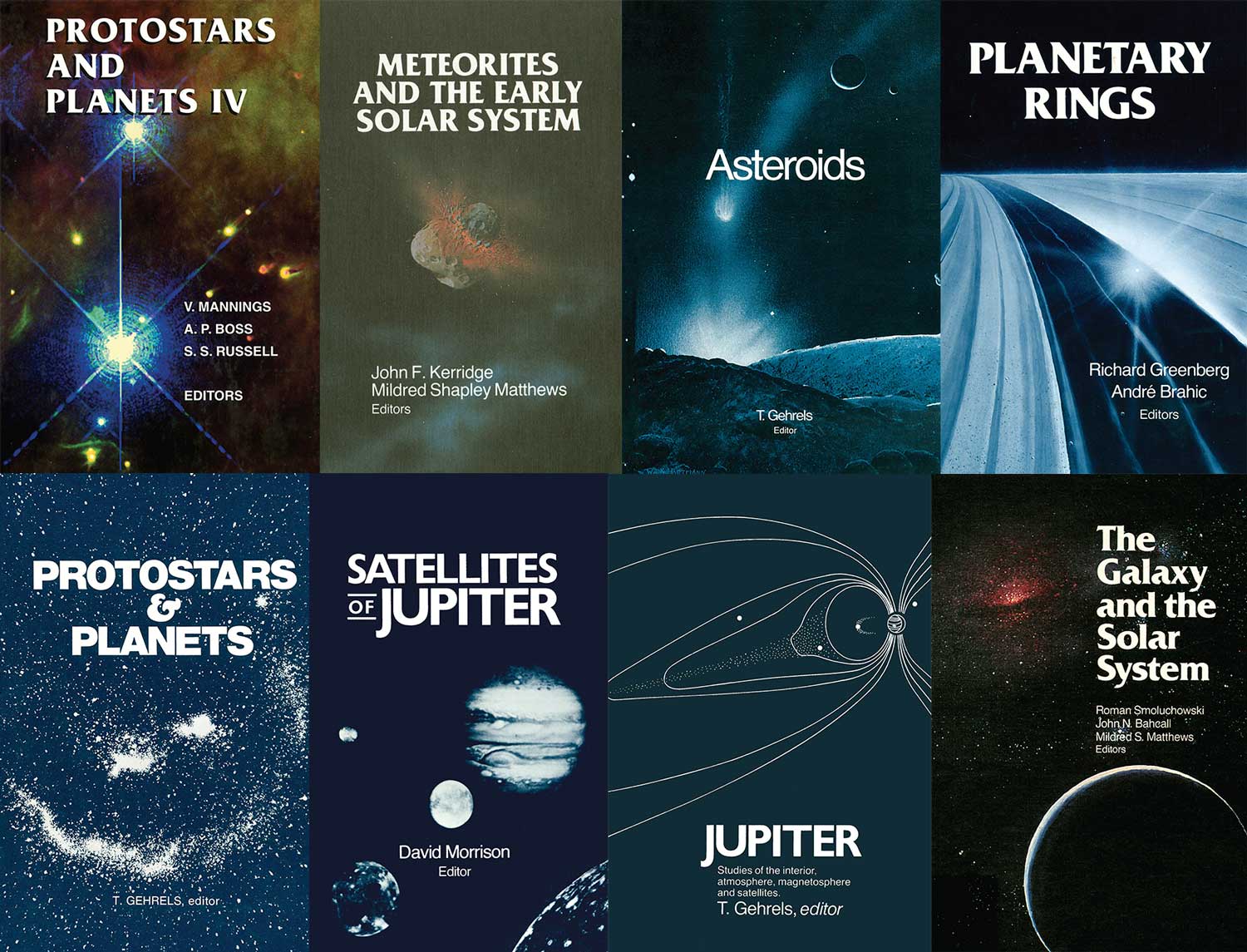
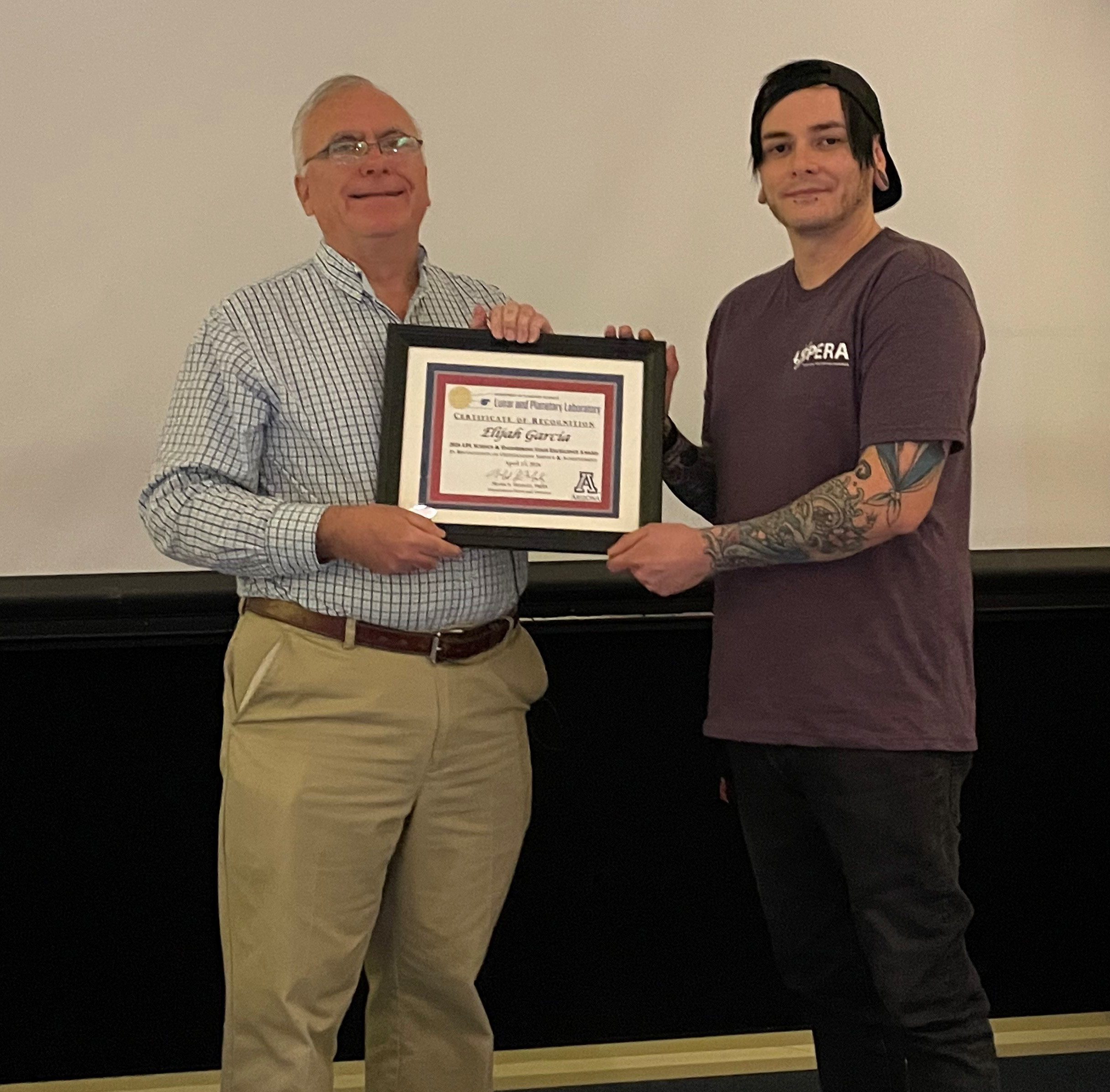 Elijah Garcia is the recipient of the LPL Staff Excellence Award for 2024 in the category of Science/Engineering Staff.
Elijah Garcia is the recipient of the LPL Staff Excellence Award for 2024 in the category of Science/Engineering Staff.
Eli is Manager of Professor Walt Harris’ Optical and Space Flight Instrumentation Development Laboratory. He began his career at LPL as a student in 2016 and soon transitioned to being an essential member of the staff, maintaining a broad range of facilities including two vacuum test systems, a clean room, a darkroom, a mechanical shop, a compressed gas handling facility, chemical storage, and two electronics fabrication stations. He keeps facilities adequately supplied and maintained ensures that users are properly trained for safe use and have required certifications. Eli also serves as procurement lead for the funded research projects in the lab, including working with vendors to develop quotes for what are often highly customized components that will be incorporated into space flight hardware.
Eli is an active participant in the field component of the user groups’ research, essentially extending his expertise beyond the lab. He handles logistics of remote test and flight operations of experiments developed in the lab and assists investigators with all phases of their effort to obtain a successful test or launch, often requiring him to travel to remote locations for up to weeks at a time, during which he has remotely attended to his regular management duties.
Eli is adept at handling needs of multiple projects simultaneously, currently managing four projects with four principal investigators, diverse facility requirements, and a constantly changing set of students, postdocs, and engineers that he keeps certified and operating independently of each other. In addition, Eli takes an active role in mentoring undergraduate students in the lab, volunteering to train these students in lab best practices and routinely goes out of his way to research new and cost-effective solutions to problems that keep our project within budgetary and schedule bounds. Under Eli’s leadership, the lab cleanroom was recommissioned to meet specific program requirements — a success that was described as a “heroic effort.” Thanks, Eli, for your outstanding work in support of optical and spaceflight instrumentation development.
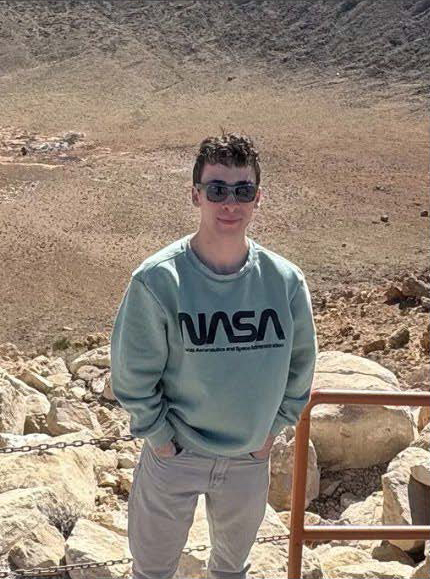 Chad Cantin
Chad Cantin
Chad is an Aerospace Engineering major with minors in Planetary Sciences and Astrobiology. Chad chose Planetary Sciences as a minor because of his long-abiding and profound interest in space. He credits enrollment in PTYS 206: Exploring our Solar System with sparking an interest in pursuing further study of the field. Chad’s favorite Planetary Sciences class has been PTYS 407: Chemistry of the Solar System taught by Dr. Dante Lauretta, principal investigator for the OSIRIS-REx mission. Chad reports the class was an incredible experience given the opportunity to learn first-hand about the OSIRIS-REx mission and its importance to the study of asteroid composition.
Chad plans to graduate in Spring 2025 with a Bachelor of Science in Aerospace Engineering; he will then pursue a Master's degree in Systems Engineering. His goal is to work as an aerospace/space systems engineer with NASA. Chad is getting a head start on his career goals this summer, when he will be working as an aeromechanics intern at NASA Ames Research Center.
Chad spent the past academic year as an Arizona/NASA Space Grant working with Professor Shane Byrne to digitize and archive lunar images from the NASA Surveyor Program. Chad also works with Dr. Jekan Thanga (Aerospace and Mechanical Engineering) in SpaceTREx Laboratories’ NASA-funded projects relating to robotic space systems engineering for lunar base applications. More specifically, his work involves designing lunar robots using computer-aided drafting and 3D printing.
When he is not doing homework or working in the lab, Chad enjoys painting and spending time outdoors. He also pursues an interest in astrophotography, using his telescope to capture observable objects in the night sky.
Pagination
- Previous page
- Page 2
- Next page

